
Namaqualand is an arid region of Namibia and South Africa, extending along the west coast over 1,000 km (600 mi) and covering a total area of 440,000 km2 (170,000 sq mi). It is divided by the lower course of the Orange River into two portions – Little Namaqualand to the south and Great Namaqualand to the north.

Adenium is a genus of flowering plants in the family Apocynaceae first described as a genus in 1819. It is native to Africa and the Arabian Peninsula.

Bulbinella is a genus of plants in the family Asphodelaceae, subfamily Asphodeloideae, first described as a genus in 1843. Many species are endemic to Cape Province in western South Africa, confined to the winter rainfall area. Other species are endemic to New Zealand, where they are most common in the central Otago region which enjoys a similar climate to the Cape Region of South Africa.
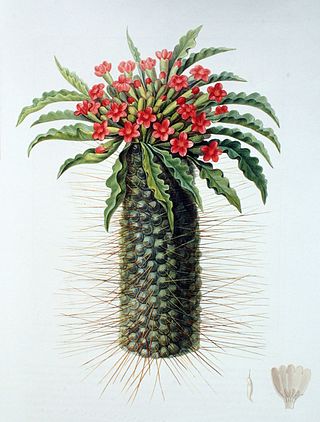
Pachypodium namaquanum, also known as halfmens or elephants trunk, is a succulent plant of Southern Africa. The genus name Pachypodium is from the Greek for 'thick foot', an allusion to its swollen base, while the species name namaquanum is a reference to Namaqualand.
Crassothonna clavifolia is a species of flowering plant in the family Asteraceae. It is found only in Namibia. Its natural habitat is rocky areas. It is threatened by habitat loss.

Aloidendron pillansii, formerly Aloe pillansii, the giant quiver tree or bastard quiver tree, is a large, branching species of succulent plant indigenous to southern Africa. It is regarded as critically endangered.

Strumaria is a genus of African plants in Amaryllis family, subfamily Amaryllidoideae. The genus is known in nature only from South Africa, Lesotho and Namibia. Almost all species flower in the autumn and are cultivated as ornamental bulbous plants.

Namaqua National Park is a South African national park situated approximately 495 km north of Cape Town and 22 km northwest of Kamieskroon. It has an area of more than 1300 km2. The park is part of Namaqualand, an area covering 55,000 km2 located within the semi-desert Succulent Karoo biome. This biome is a biodiversity hotspot with the largest concentration of succulent plants in the world. The park also has an arid environment with succulent plants. The park was created to protect its flowers. During the spring, wildflowers bloom there in a spectacular fashion. The park's main tourist attraction is this abundant spring bloom of brightly coloured wildflowers.

The ǀAi-ǀAis/Richtersveld Transfrontier Park is a peace park straddling the border between South Africa and Namibia. It was formed in 2003 by combining the Namibian ǀAi-ǀAis Hot Springs Game Park and the South African Richtersveld National Park. Most of the South African part of the park forms part of the buffer zone of the Richtersveld Cultural and Botanical Landscape World Heritage Site, which measures 5,920 square kilometres (2,290 sq mi). The Fish River Canyon is located in the park, the largest canyon in Africa. A memorandum of understanding was signed on 17 August 2003 by the presidents of South Africa and Namibia, which formalised the establishment of the park. |Ai-|Ais means ‘burning water’, after the hot springs of the same name.

Aloe pearsonii is a very distinctive and unusual species of aloe, that is naturally endemic to the arid Richtersveld area on the border between South Africa and Namibia.

Codon is a small genus of plants from South Africa in the family Codonaceae in the order Boraginales. The genus Codon comprises two species.
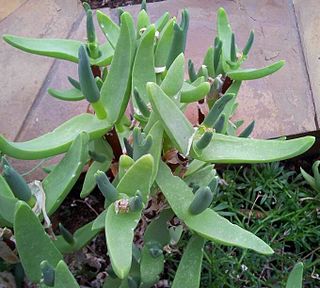
Mitrophyllum is a genus of succulent plants of the family Aizoaceae, indigenous to the arid region around the Richtersveld, on the border of South Africa and Namibia.
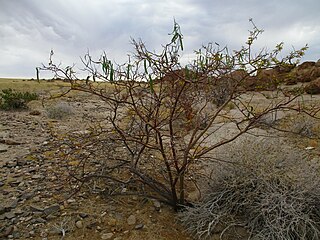
Entada rangei, commonly known as the skew-leaved elephant-root, is a species of flowering plant in the family Fabaceae. It is a deciduous, multi-stemmed shrub or rarely a tree of 4 to 8 meters tall, which may be found on hills as well as plains. The type material was obtained south of Humbe, Angola. E. rangei of southern Namibia is now considered a synonym.

Colpias is a monotypic genus of flowering plant in the family Scrophulariaceae. It has only one currently accepted species, Colpias mollis, native to South Africa. It secretes oils to attract specialised oil-collecting bees from the genus Rediviva. It is also known by the name klipblom, meaning stone plant in Afrikaans.

Ornithoglossum undulatum, also known as the Karoo Slangkop, is a species of flowering plant in the family Colchicaceae. It is found in Southern Namibia and South Africa. In South Africa its range extends as far east as Somerset East in Eastern Cape Province. O. undulatum is a poisonous plant, and consumption of the leaves can kill livestock.

Tylecodon paniculatus, also known as butter bush, butter tree, butterboom or rooisuikerblom (Afrikaans), is a species of succulent plant in the genus Tylecodon belonging to the family Crassulaceae.
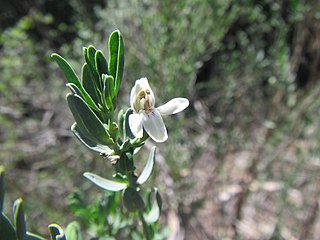
Justicia cuneata is a species of shrub in the genus Justicia. It is endemic to the Cape Provinces of South Africa.
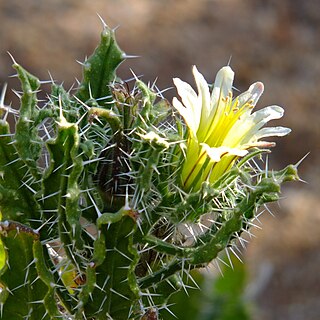
Codon royenii is a species of flowering plant in the genus Codon. It is native to Namibia and the Northern Cape Province of South Africa. It is also known by the names honey bush or white nectarcup, or in Afrikaans as heuningbos and suikerkelk.
Eoanthidium turnericum is a species of bee in the genus Eoanthidium. It is endemic to Southern Africa.




















